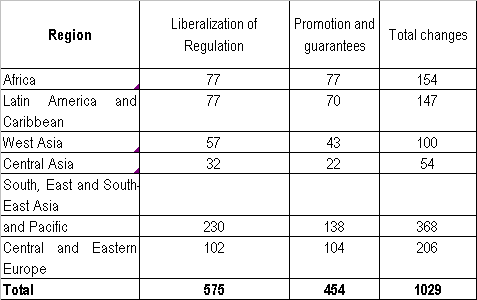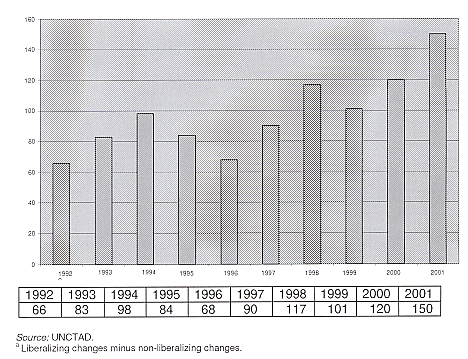A study of changes in regulations affecting inflows of foreign direct investment (FDI) during the 1990s, to be published in the forthcoming April issue of UNCTAD´s journal Transnational Corporations (1) , confirms the shift in developing countries from State- directed, inward-looking economic strategies to an acceptance of markets and integration into the world economy. The number of policy adjustments effected each year ranged from 66 to 150 between 1992 and 2001, and 95% of them were liberalizing (figure 1). All but two of the 116 developing countries and economies in transition included in the study either repealed or loosened regulatory restrictions affecting FDI, or offered new incentives or guarantees designed to attract foreign investors. Expectations of benefits from FDI were the main driver. Comments Karl P. Sauvant, Director of UNCTAD´s Investment Division: "The regulatory framework to attract FDI is now largely in place, and as a result, an increasing number of countries are paying more attention to how the benefits from such investment can be maximized".
The author of the study, Professor Stephen J. Kobrin (The Wharton School, University of Pennsylvania), found that four policy categories accounted for 80% of the changes: easing or removal of operational constraints, such as local content regulations; opening additional sectors (e.g. power generation) to foreign investors; additional promotional activities and incentives designed to attract investment; and guarantees against adverse future actions. Incentives dominated other changes in policy. Three quarters of the countries offered new incentives at least once over the decade, and almost a third (32%) of all the liberalizing initiatives took the form of promotional activity rather than easing of restrictive regulation.
The Asian countries were particularly active liberalizers: the 24 countries in South, East and South-East Asia accounted for over one third of all of the FDI policy changes (table 1). China, India and Viet Nam stood out as the most active liberalizers over the course of the decade. The relatively high number of liberalizing changes in the ex-socialist countries of Central and Eastern Europe reflects their transition to a market economy. The Asian and Central and Eastern European countries together accounted for over half of the total FDI policy liberalizations during the years covered by the study. Africa and Latin America and the Caribbean followed suit.
What determines whether a country liberalizes FDI policy? The most important factor was country size, measured in terms of either population or GDP: larger countries were thus more prone to liberalizing. Furthermore, countries at higher levels of development - i.e. those with higher levels of human resource capabilities and/or higher per capita incomes - were also more likely to liberalize FDI policy. Country size affects both bargaining power vis-à-vis investors and the likelihood of FDI taking the form of investment aimed at the domestic market. Countries at higher development levels are more likely to be able to take advantage of spillovers of technology, managerial abilities and other capabilities associated with FDI.
ANNEX
Tables and figures
Table 1. Liberalizing FDI policy changes: 116 developing countries and economies in transition, 1992-2001 (number)
Source: Source: UNCTAD.
Figure 1. Liberalizing FDI policies: total neta FDI regulatory changes, 1992-2001 (Number)


